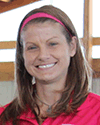
Don’t skimp on the details and you’ll find the lost dollars (Part 2)
 By Dr. Laurie Winkelman
By Dr. Laurie WinkelmanIn Part 1of this article series, we discussed the details involved in good forage and feeding management to help prevent lost dollars. This second article will focus on the details of cow comfort and reproductive management to help boost your farm’s bottom line regardless of the milk markets.
Details in cow comfort and housing
- Are your stalls full of bedding and as comfortable as they can be for the cow?
- Are you using footbaths regularly to keep digital dermatitis and lameness problems to a minimum? Lame cows don’t like to eat, and then they don’t like to milk.
- Is your heat abatement program efficient? Do you have fans over freestalls, a sprinkler or soaker line in the feed lane, and cooling in the holding area? Do you increase feed deliveries during heat stress to reduce secondary heating of feed? Are the fan blades clean? Are fan belts tight to keep the RPMs and airflow at maximum potential?
- Are waterers cleaned regularly and available for unlimited drinking?
- Does your milking team execute their milking routines properly to achieve a low somatic cell count (SCC)? SCC premiums vary by processor, but can add a lot to the milk check.
- Let’s say, as an example, a bonus of 50 cents per cwt can be captured to lower SCC from 200,000 to under 100,000 on a 400-cow dairy averaging 90 pounds. This farm ships 360 cwt per day, and thus 131,400 cwt in a year. An additional 50 cents per cwt would be $65,700 per year of income.
Details in reproductive management
- Are you doing your best to ensure a steady stream of fresh cows and replacements for the long term?
- If utilizing synchronization programs, is the timing of the injections exactly where they are supposed to be or has protocol drifted from where you started?
- Are you detecting open cows quickly so action can be taken to get them back on track to becoming pregnant? Sometimes, farms reduce the frequency in their herd checks and pregnancy exams during tough financial times. This can result in more cows that fall through the cracks in the program if heat detection is not perfect. You want to keep a steady stream of fresh cows in future months to capture the higher milk prices when they eventually come back around.
It would cost somewhere around $4 per cow per year for each additional day that a cow is open. If your herd days open increase 10 days per cow because of shifting protocols, or reduce herd checks to save short-term cost, this would be $40 per cow per year. On a 400-cow dairy, this would cost $16,000.
In short, look around your farm and see if some of the details have slipped over time. You’ll likely see at least one or two things that can impact your bottom line more than tweaking a few minor things to lower your feed costs.
About the author: Dr. Laurie Winkelman grew up on a 130-cow Holstein and Brown Swiss farm in southeast Wisconsin. Following high school, she attended the University of Wisconsin-Madison, where she double-majored in dairy science and agricultural journalism and graduated in 2003. She then attended The Ohio State University to earn her master’s degree. Her research focused on the concept of limiting energy intake in prepartum transition dairy cows. After completing her master’s, Winkelman worked for Ohio State as the dairy program specialist, overseeing the youth and 4-H dairy programs for the state as well as working with multi-state extension programs, such as the Tri-State Dairy Nutrition Conference. In 2007, she moved to Ithaca, New York to pursue her Ph.D. at Cornell University. There she examined the role of insulin in milk protein synthesis in lactating cows. Following completion of her Ph.D. in early 2011, Winkelman began working with Vita Plus as a nutritionist and member of the technical services team in northeast Wisconsin.
| Category: |
Cow comfort Dairy Performance Facility design Transition and reproduction |

